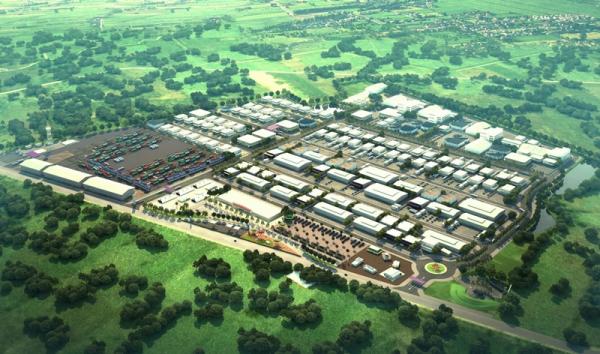เขตเศรษฐกิจพิเศษประเทศไทย คือ บริเวณพื้นที่ที่คณะกรรมการนโยบายเขตพัฒนาเศรษฐกิจพิเศษ (กนพ.) กำหนดให้เป็นเขตพัฒนาเศรษฐกิจพิเศษ ซึ่งรัฐจะสนับสนุนโครงสร้างพื้นฐาน สิทธิประโยชน์การลงทุน การบริหารแรงงานต่างด้าวแบบไป-กลับ การให้บริการจุดเดียวเบ็ดเสร็จและการบริการอื่นที่จำเป็น1

ตัวอย่างเขตเศรษฐกิจพิเศษ สระแก้ว กำลังดำเนินการพัฒนาบริเวณชายแดนไทย-กัมพูชา ส่วนหนึ่งของระเบียงเศรษฐกิจตอนใต้ของอนุภูมิภาคลุ่มน้ำโขง เน้นการขนส่งสินค้าจากไทยไปยังเวียดนามใต้ อุตสาหกรรมหลัก ได้แก่ เกษตรกรรม เฟอร์นิเจอร์ อัญมณี อิเล็กทรอนิกส์ พลาสติก ยา การท่องเที่ยว เป็นต้น ที่มา: สำนักงานต่างประเทศ รัฐบาลไทย
การจัดตั้งเขตเศรษฐกิจพิเศษบริเวณชายแดนของประเทศไทย เริ่มจากการผลักดันของธนาคารพัฒนาเอเชีย (Asian Development Bank: ADB) ภายใต้กลยุทธ์ส่งเสริมการใช้ประโยชน์จากโครงการระเบียงเศรษฐกิจ ในปี พ.ศ. 2541 โดยกำหนดการพัฒนาเขตเศรษฐกิจพิเศษชายแดนใส่ในแผนปฏิบัติการเพื่อการเปลี่ยนระเบียงการขนส่ง (Transport Corridors) ให้เป็นระเบียงเศรษฐกิจ (Economic Corridors)2
31 มี.ค. 2556 มติคณะรัฐมนตรีมอบหมายสำนักงานคณะกรรมการพัฒนาเศรษฐกิจและสังคมแห่งชาติ (สศช.) ศึกษาความเหมาะสมการจัดตั้งเขตเศรษฐกิจพิเศษ3 เพื่อนำนโยบายเขตพัฒนาเศรษฐกิจพิเศษเป็นส่วนหนึ่งของแผนที่นำทางในการเข้าสู่ประชาคมอาเซียน
ปี 2557 ประเทศไทยโดยคณะรักษาความสงบแห่งชาติได้ประกาศนโยบายเขตพัฒนาเศรษฐกิจพิเศษ เพื่อสร้างฐานการผลิตเชื่อมโยงกับอาเซียนและพัฒนาเมืองชายแดน และได้มีคําสั่งที่ 72/2557 เมื่อวันที่ 19 มิถุนายน 2557 แต่งตั้งคณะกรรมการนโยบายเขตพัฒนาเศรษฐกิจพิเศษ (กนพ.) โดยมีหัวหน้าคณะรักษาความสงบแห่งชาติเป็นประธาน มี สศช. เป็นฝ่ายเลขานุการ และมีคณะอนุกรรมการหลักๆ อีก 6 คณะ ทําหน้าที่ขับเคลื่อนงานด้านต่างๆ ที่เป็นหัวใจสําคัญของเขตพัฒนาเศรษฐกิจพิเศษทั้งในส่วนกลางและระดับพื้นที่4
ในปีถัดมา มีประกาศกำหนดพื้นที่เขตพัฒนาเศรษฐกิจพิเศษ ตามหลักเกณฑ์และจัดลำดับความสำคัญของพื้นที่ชายแดนที่มีศักยภาพและเหมาะสมพัฒนาเป็นเขตพัฒนาเศรษฐกิจพิเศษ จำนวน 10 จังหวัด โดยแบ่งเป็น 2 ระยะ ดังนี้5
ระยะแรก 5 จังหวัด ได้แก่ ตาก มุกดาหาร สระแก้ว ตราด และสงขลา ประกอบด้วย 10 อำเภอ 36 ตำบล (เริ่มดำเนินการได้ในปี 2558)
ระยะที่สอง 5 จังหวัด ได้แก่ หนองคาย นราธิวาส เชียงราย นครพนม และกาญจนบุรี ประกอบด้วย 12 อำเภอ 55 ตำบล (เริ่มดำเนินการในปี 2559)
กรอบแนวคิดในการพัฒนาเขตเศรษฐกิจพิเศษของไทย
กนพ. ได้กำหนดแผนการพัฒนาเขตเศรษฐกิจพิเศษ โดยมีวัตถุประสงค์สำคัญให้เกิดการกระจายความเจริญสู่ภูมิภาคโดยใช้โอกาสจากอาเซียน ลดความเหลื่อมล้ำทางรายได้ ยกระดับคุณภาพชีวิตของประชาชน และเสริมสร้างความมั่นคงในพื้นที่บริเวณชายแดน รวมทั้ง เพิ่มความสามารถในการแข่งขันและการเชื่อมโยงกับประเทศเพื่อนบ้าน6
ช่วงแรกของการดำเนินงาน เป็นการเตรียมความพร้อมในพื้นที่และกำหนดรูปแบบ การพัฒนาที่เหมาะสม ภาครัฐเป็นกลไกสำคัญในการขับเคลื่อนการพัฒนาให้เป็นไปตามเป้าหมายและอำนวยความสะดวกการลงทุนของภาคเอกชนในพื้นที่ชายแดนทั้ง 10 แห่ง
แนวทางการดำเนินงาน
กนพ. เปิดโอกาสให้จังหวัดเป็นผู้จัดทำข้อเสนอการพัฒนาเป็นเขตพัฒนาเศรษฐกิจพิเศษชายแดน ซึ่งครอบคลุมขอบเขตพื้นที่ที่จะพัฒนาเป็นเขตพัฒนาเศรษฐกิจพิเศษชายแดน กิจกรรมที่ต้องการพัฒนาในพื้นที่ โครงสร้างพื้นฐานที่ต้องการได้รับการพัฒนา และสิทธิประโยชน์ด้านการลงทุนที่ต้องการได้รับการสนับสนุน โดยข้อเสนอดังกล่าวต้องผ่านกระบวนการมีส่วนร่วม ของประชาชนและภาคส่วนต่างๆ ในพื้นที่ การพิจารณาของคณะอนุกรรมการภายใต้ กนพ. ในด้านที่เกี่ยวข้อง และนําเสนอต่อ กนพ. และคณะรัฐมนตรีพิจารณาตามขั้นตอน เมื่อ กนพ. และคณะรัฐมนตรีเห็นชอบแล้ว หน่วยงานที่เกี่ยวข้องจะดําเนินการแผนงาน โครงการ และมาตรการต่างๆ ตามมติคณะรัฐมนตรี โดยนับตั้งแต่ปี 2557 เป็นต้นมา กนพ. ได้ดำเนินการขับเคลื่อนยุทธศาสตร์ต่างๆ ในพื้นที่เขตพัฒนาเศรษฐกิจพิเศษ 10 จังหวัด ดังนี้7
1. กำหนดพื้นที่เขตพัฒนาเศรษฐกิจพิเศษ ระยะที่ 1 และระยะที่ 2 รวม 10 จังหวัด
2. การจัดหาที่ดินและการบริหารจัดการ
ในรัฐบาล คสช. สั่งการเรื่องการจัดหาที่ดินเพื่อการใช้ประโยชน์สำหรับการพัฒนาเขตพัฒนาเศรษฐกิจพิเศษ ทั้งในส่วนของการพัฒนาโครงสร้างพื้นฐาน ถนน ด่านศุลกากร และนิคมอุตสาหกรรมเพื่อให้ภาคเอกชนเช่าดำเนินกิจกา
3. การให้สิทธิประโยชน์ด้านการลงทุน อาทิเช่น
- สิทธิประโยชน์สำหรับนักลงทุนในเขตพัฒนาเศรษฐกิจพิเศษชายแดน กรณีกิจการทั่วไปตามประกาศ กกท. ที่ 2/2557 และกรณีกิจการเป้าหมายตามที่ กนพ. กำหนด ซึ่งกิจการเป้าหมายในการส่งเสริมการลงทุน มี 13 กลุ่มกิจการ 62 ประเภทกิจการย่อย และภายหลังได้ให้ความเห็นชอบเพิ่มเติมอีก 10 ประเภทกิจการย่อย
- สิทธิประโยชน์สำหรับผู้ประกอบการวิสาหกิจขนาดกลางและขนาดย่อม เช่น มาตรการด้านภาษีและสินเชื่อ
- สิทธิประโยชน์ด้านการเช่าที่ดินในเขตพัฒนาเศรษฐกิจพิเศษ
4. การจัดตั้งศูนย์บริการเบ็ดเสร็จด้านการลงทุน (OSS) ในแต่ละพื้นที่
5. การจัดระบบแรงงานข้ามชาติ ให้สามารถเข้ามาทำงานในลักษณะไป-กลับ ในพื้นที่เขตเศรษฐกิจพิเศษเชียงราย ตาก และกาญจนบุรี
6. การลงทุนด้านโครงสร้างพื้นฐานและด่านศุลกากร ช่วยอำนวยความสะดวกให้เกิดการขยายตัวของการค้าชายแดนระหว่างประเทศไทยกับประเทศเพื่อนบ้านในระยะ 2 ทศวรรษที่ผ่านมาและในอนาคต8
7. การจัดทำผังเมืองรวมเขตพัฒนาเศรษฐกิจพิเศษชายแดน
มีการจัดทำผังการใช้ประโยชน์ที่ดิน ผังคมนาคมขนส่ง รวมทั้งการออกแบบการกำหนดโซนนิ่งระดับย่าน พร้อมวางระบบสาธารณูปโภค สาธารณูปการ ให้สอดคล้องกับพื้นที่และสอดคล้องกับโอกาสขยายตัวในอนาคต
จากข้อมูลของสำนักงานคณะกรรมการส่งเสริมการลงทุนล่าสุด พบว่ามีโครงการที่ได้รับการอนุมัติส่งเสริมการลงทุนในเขตพัฒนาเศรษฐกิจพิเศษ 8 จังหวัด จำนวน 52 โครงการ มูลค่าการลงทุนรวม 9,059 ล้านบาท โดยเขตพัฒนาเศรษฐกิจพิเศษตากเป็นพื้นที่ศักยภาพการลงทุนสูงที่สุด จำนวน 28 โครงการ ซึ่งเกี่ยวกับเสื้อผ้าสำเร็จรูป ผลิตภัณฑ์พลาสติก อุตสาหกรรมยานยนต์ เครื่องจักรและชิ้นส่วน เป็นต้น รองลงมาคือ เขตพัฒนาเศรษฐกิจพิเศษสงขลา สระแก้ว และมุกดาหาร9
ความท้าทายด้านกฎหมายและนโยบาย
ด้วยพัฒนาการด้านกฎหมายและกลไกทางนโยบายที่อำนวยความสะดวกให้เกิดเขตเศรษฐกิจพิเศษ แต่ก็ได้รับการต่อต้านจากองค์กรภาคประชาสังคม ชุมชน และหน่วยงานท้องถิ่นที่ระบุว่า นโยบายที่ประกาศใช้ส่วนใหญ่เอื้อต่อความต้องการของนักลงทุนมากกว่าความต้องการของคนในท้องถิ่น ผลงานการศึกษาล่าสุด10พยายามวิเคราะห์ช่องว่างของนโยบายและพบประเด็นสำคัญที่ควรกล่าวถึง ดังนี้
- การเกิดเขตเศรษฐกิจพิเศษชายแดนจากความร่วมมือทางเศรษฐกิจของประเทศในกลุ่มอาเซียน ถือเป็นเรื่องยาก ทั้งนี้ขึ้นอยู่กับระดับการพัฒนาที่แตกต่างกันของแต่ละประเทศสมาชิก
- ตัวอย่างเช่น ต้นทุนแรงงานในประเทศไทยสูงกว่าประเทศเพื่อนบ้าน อย่างพม่า กัมพูชา และลาว ประมาณ 3-5 เท่า ถือเป็นการคุกคามต่อค่าจ้างงานในท้องถิ่น ในขณะที่เศรษฐกิจไทยเติบโตจากการจ้างแรงงานไร้ฝีมือกว่า 6 ล้านคน
- การนำสินค้าข้ามชายแดนในปริมาณที่เพิ่มขึ้นช่วยให้ผู้บริโภคในประเทศเพื่อนบ้านซื้อสินค้าได้มากขึ้นในราคาที่ถูกลง ซึ่งส่งผลดีและผลเสียต่อเศรษฐกิจของทั้งสองประเทศ
ในปัจจุบัน การพัฒนาเขตเศรษฐกิจพิเศษเป็นหนึ่งในนโยบายของรัฐที่สำคัญ จึงไม่ใช่เรื่องง่ายที่จะลงมือปฏิบัติ โดยพบว่า มีความกังวลและผลกระทบจากการกำหนดนโยบายและข้อกฎหมายต่างๆ มากมาย จนเป็นที่วิพากษ์วิจารณ์ และองค์กรภาคประชาสังคมจับตาตรวจสอบกระบวนการดำเนินการ เช่น นโยบายการใช้ประโยชน์ที่ดิน การจัดการในเขตเศรษฐกิจพิเศษ ผลกระทบต่อสิ่งแวดล้อม และปัญหาการจัดการน้ำ ฯลฯ อ่านเพิ่มเติม.
เรื่องที่เกี่ยวข้องกับเขตพัฒนาเศรษฐกิจพิเศษ
- พรบ. เขตเศรษฐกิจพิเศษ และกฎหมายที่เกี่ยวข้อง
- ผลกระทบทางสังคมและสิ่งแวดล้อมจากการส่งเสริมการพัฒนาเขตเศรษฐกิจพิเศษ
References
- 1. สำนักงานยุทธศาสตร์และการวางแผนพัฒนาพื้นที่ สำนักงานคณะกรรมการพัฒนาเศรษฐกิจ. สิงหาคม 2559. เขตเศรษฐกิจพิเศษในประเทศไทย. กรุงเทพฯ.
- 2. สถาบันระหว่างประเทศเพื่อการค้าและการพัฒนา (องค์การมหาชน). 2558. แนวทางและมาตรการเพื่อการพัฒนาเขตเศรษฐกิจพิเศษบริเวณพื้นที่แนวชายแดนของไทย. กรุงเทพฯ.
- 3. สำนักงานคณะกรรมการส่งเสริมการลงทุน. วารสารส่งเสริมการลงทุน ปีที่ 25 ฉบับที่ 11 พฤศจิกายน 2557. กรุงเทพฯ. หน้า 9. สืบค้นเมื่อ พฤษภาคม 2561.
- 4. สำนักงานยุทธศาสตร์และการวางแผนพัฒนาพื้นที่ สำนักงานคณะกรรมการพัฒนาเศรษฐกิจ. กันยายน 2559. เขตพัฒนาเศรษฐกิจพิเศษชายแดน. กรุงเทพฯ.
- 5. สภาพัฒนาองค์กรชุมชน (องค์การมหาชน). ข่าว: เขตเศรษฐกิจพิเศษโอกาสหรือภัยคุกคามชุมชน. วันที่ 29 พฤษภาคม 2558. สืบค้นเมื่อ พฤษภาคม 2561.
- 6. สำนักงานยุทธศาสตร์และการวางแผนพัฒนาพื้นที่ สำนักงานคณะกรรมการพัฒนาเศรษฐกิจ. พฤษภาคม 2561. PowerPoint: นโยบายเขตพัฒนาเขตเศรษฐกิจพิเศษชายแดน (ภาษาไทย). สืบค้นเมื่อ พฤษภาคม 2561.
- 7. สภาพัฒนาองค์กรชุมชน (องค์การมหาชน). 2560. ความท้าทายเศรษฐกิจชุมชนท้องถิ่นในพื้นที่เขตเศรษฐกิจพิเศษ. กรุงเทพฯ
- 8. ดร.เชิญ ไกรนรา. 2560. การค้าชายแดนระหว่างประเทศไทยกับประเทศเพื่อนบ้าน. ไฟล์นำเสนอ ณ วิทยาลัยสหวิทยาการ มหาวิทยาลัยธรรมศาสตร์ ศูนย์ลำปาง. 28 ตุลาคม 2560. ลำปาง.
- 9. สำนักงานคณะกรรมการพัฒนาเศรษฐกิจและสังคมแห่งชาติ. ไฟล์นำเสนอ: นโยบายเขตพัฒนาเขตเศรษฐกิจพิเศษชายแดน. ปรับปรุงเมื่อวันที่ 9 กรกฎาคม 2561.
- 10. ดร.เชิญ ไกรนรา และ Dr.Jayant K.Routray. 2561. Policy Mechanism for Developing Special Border Economic Zones in Thailand. กรุงเทพฯ.

